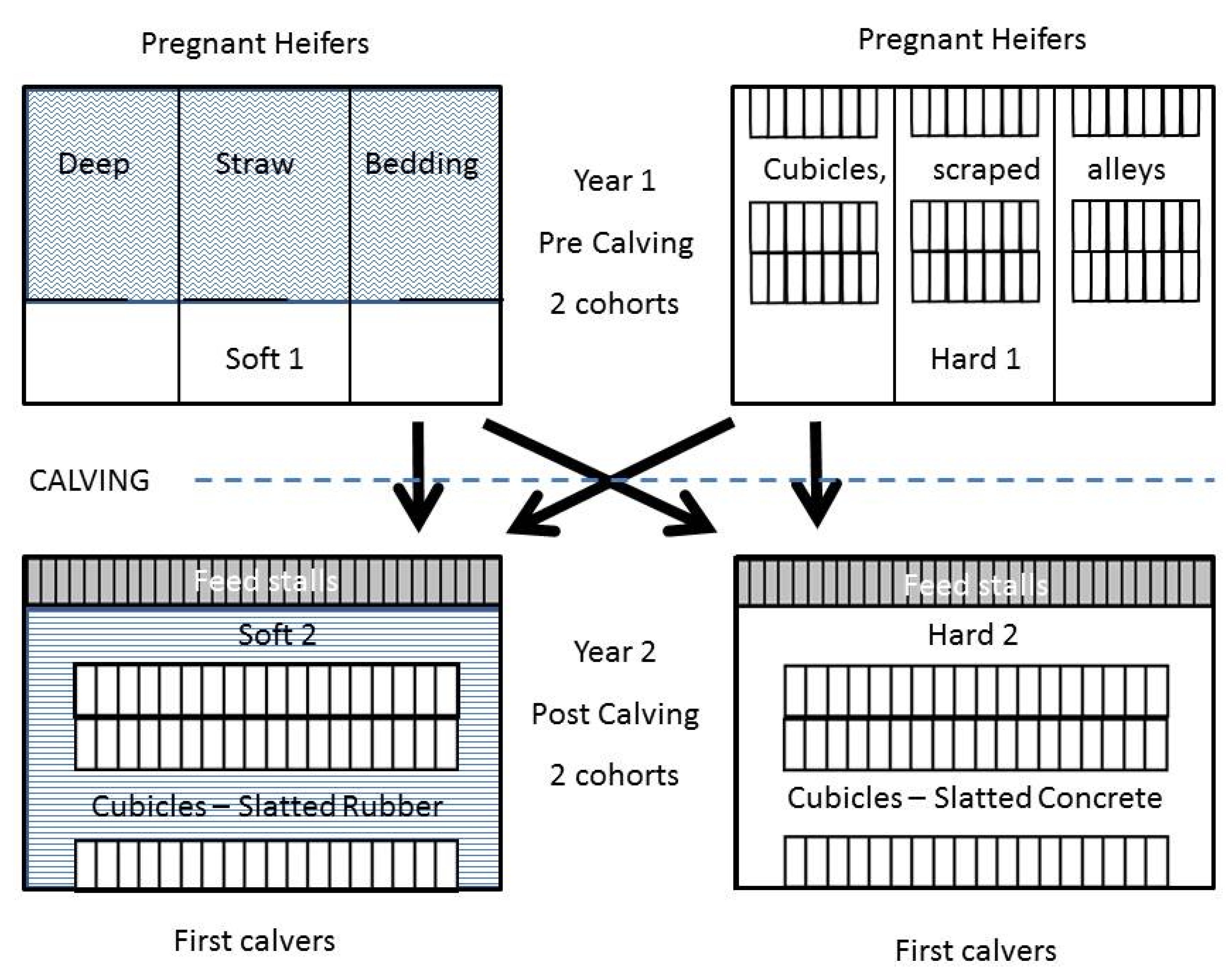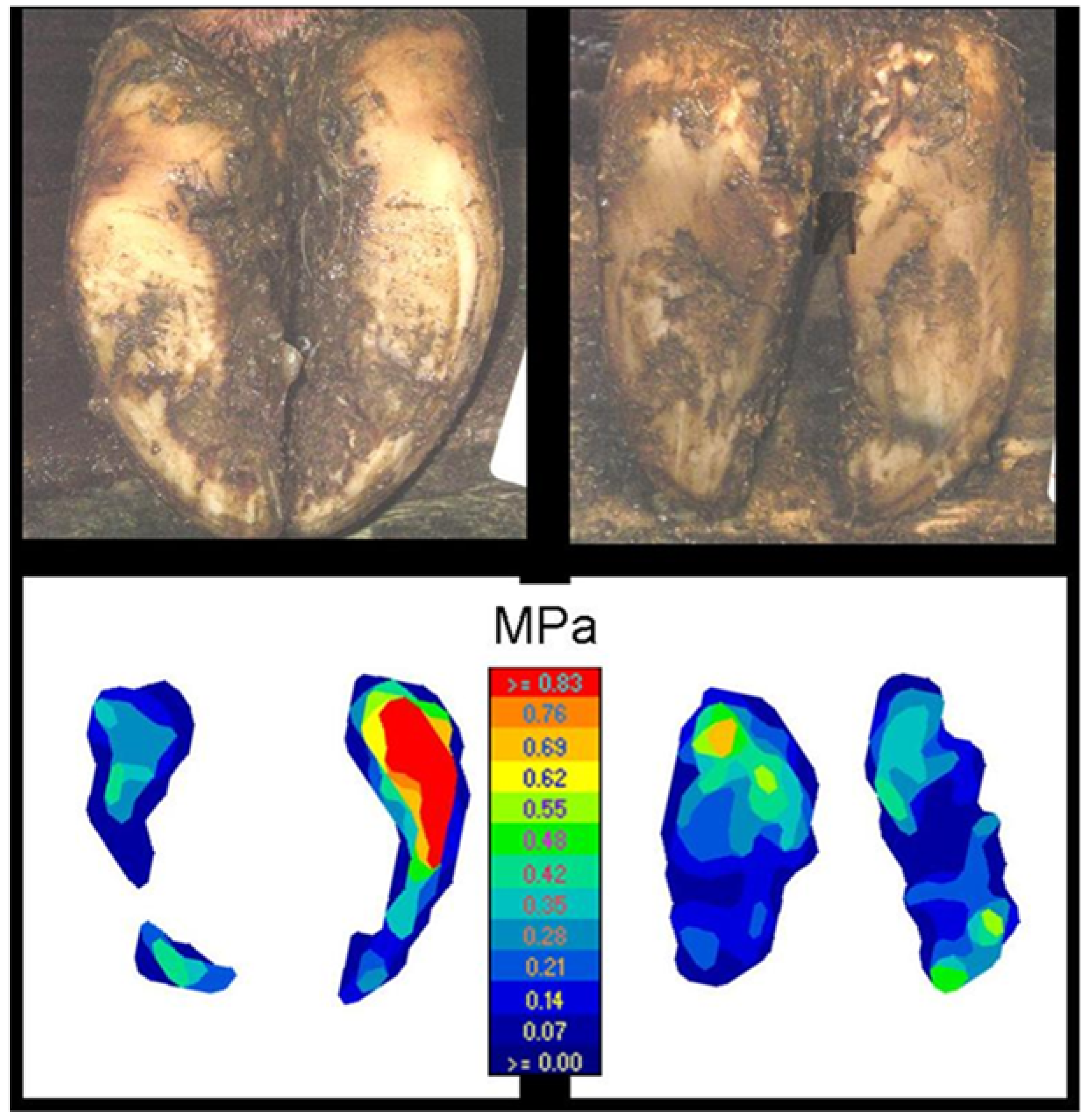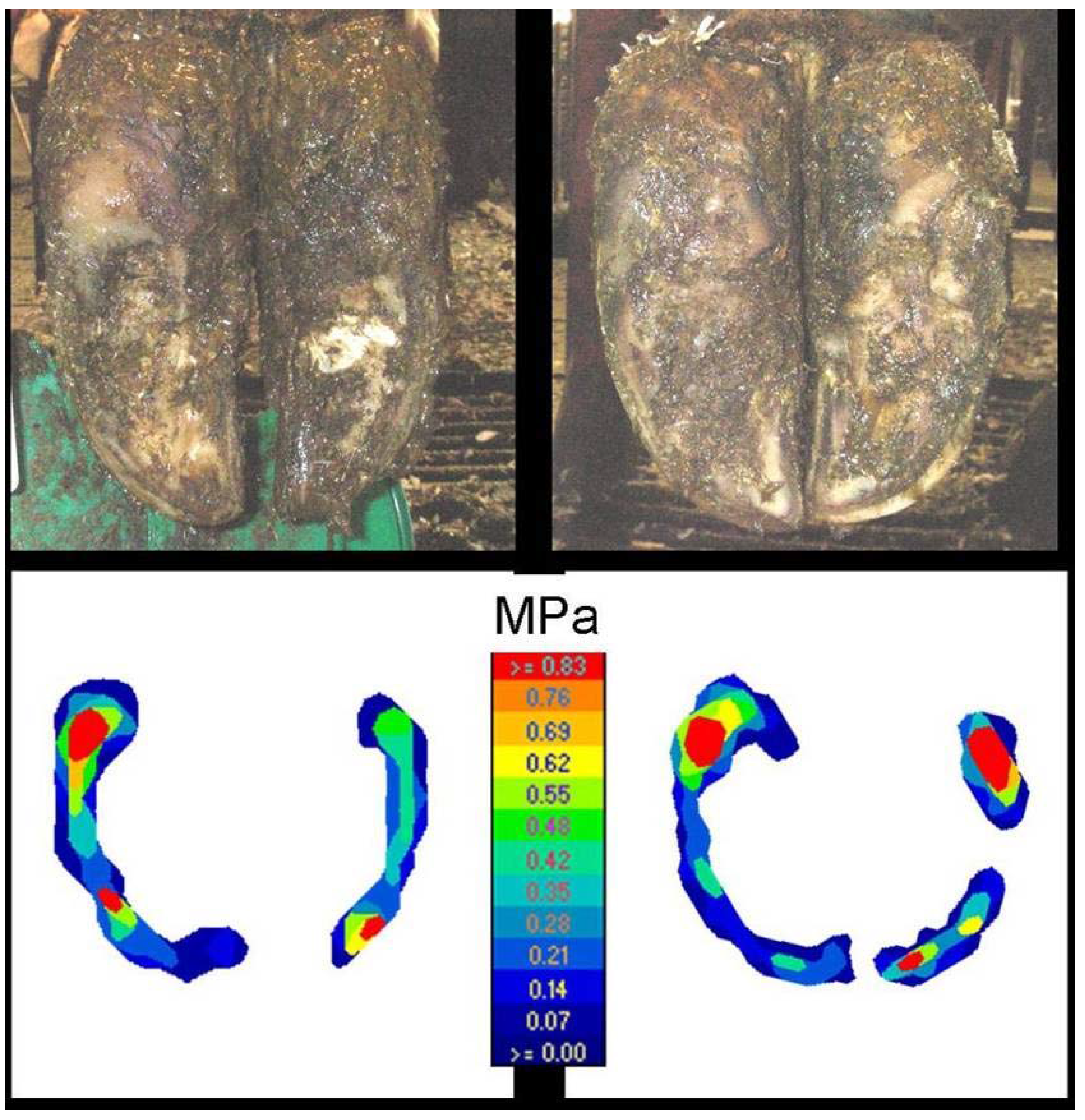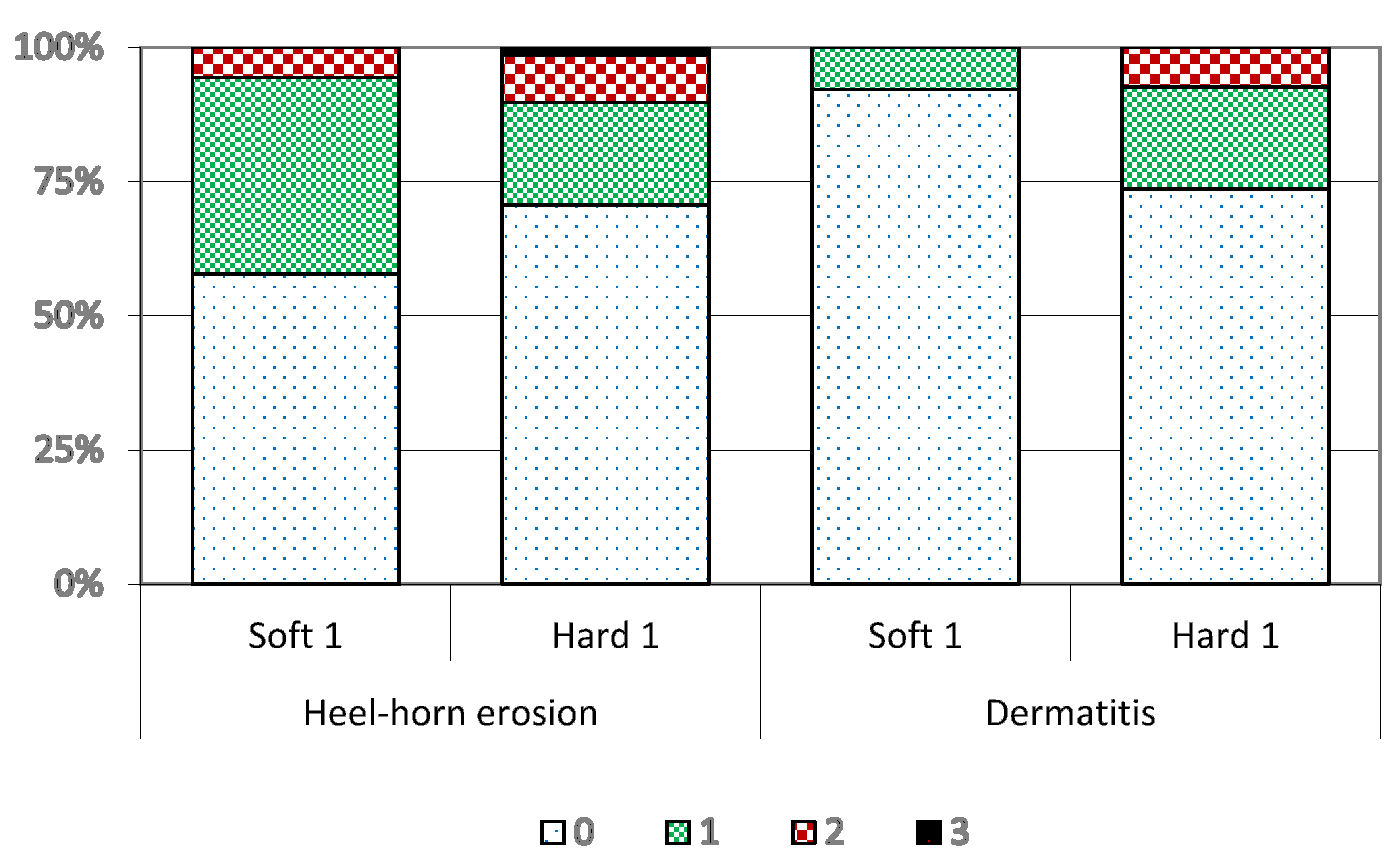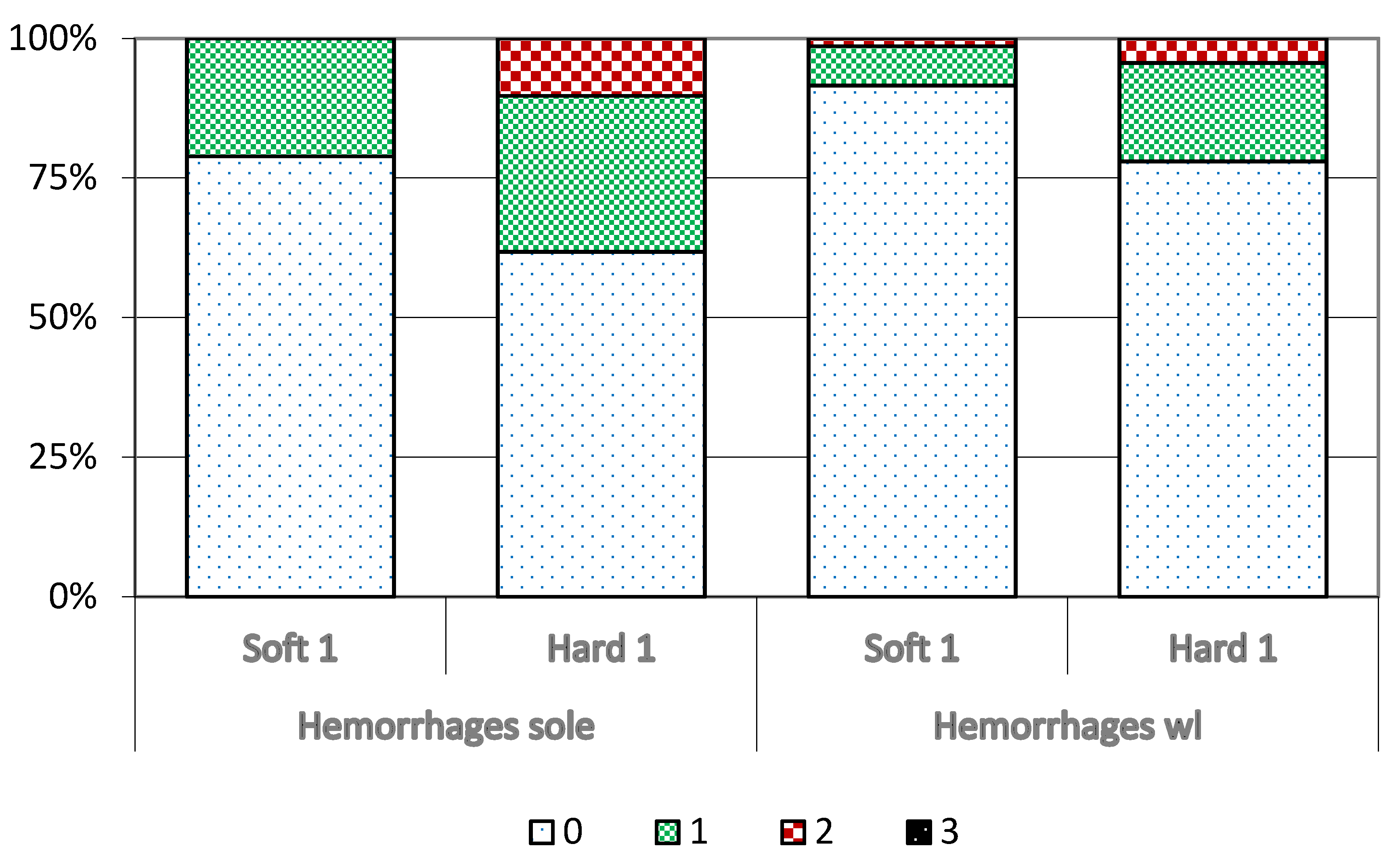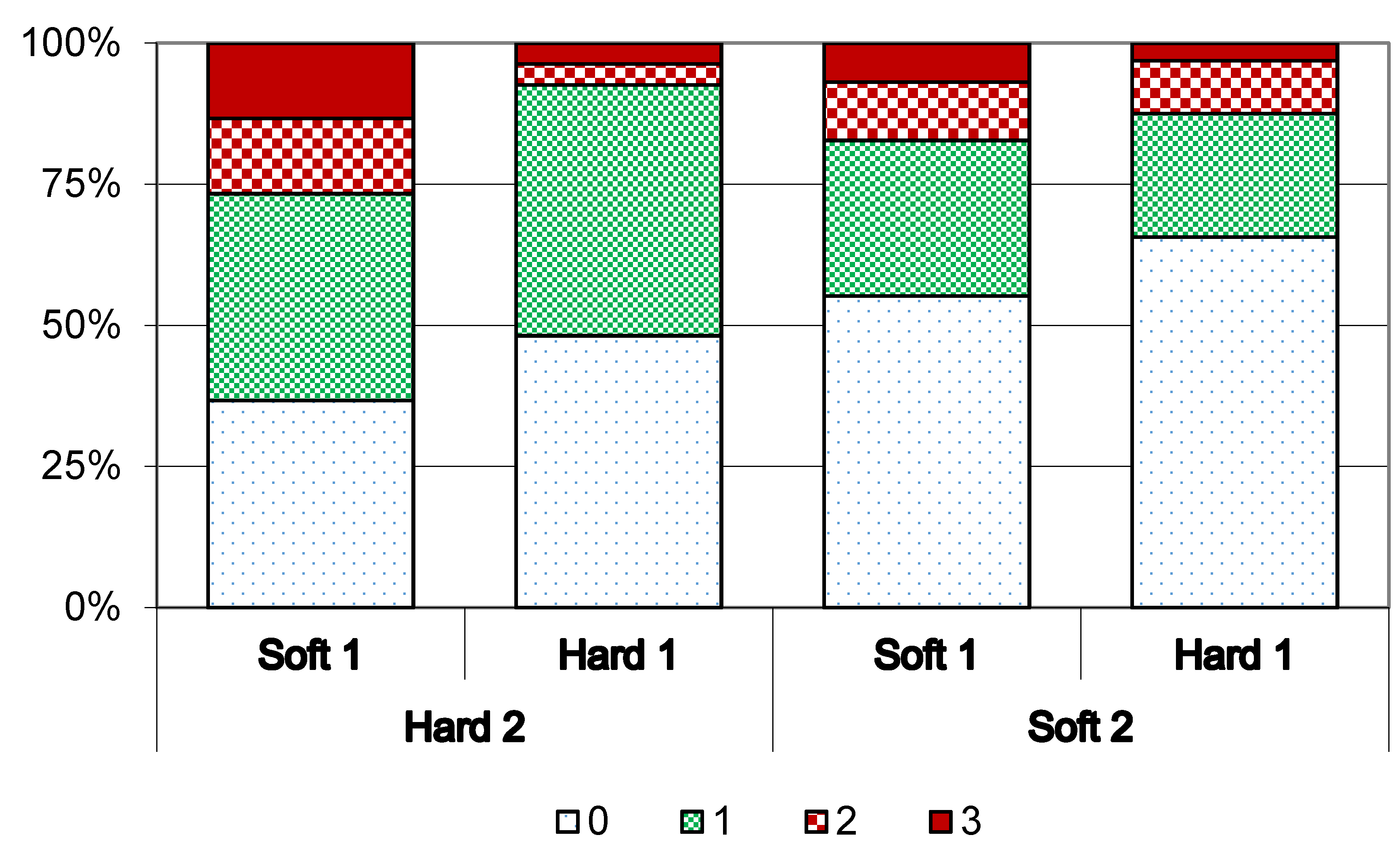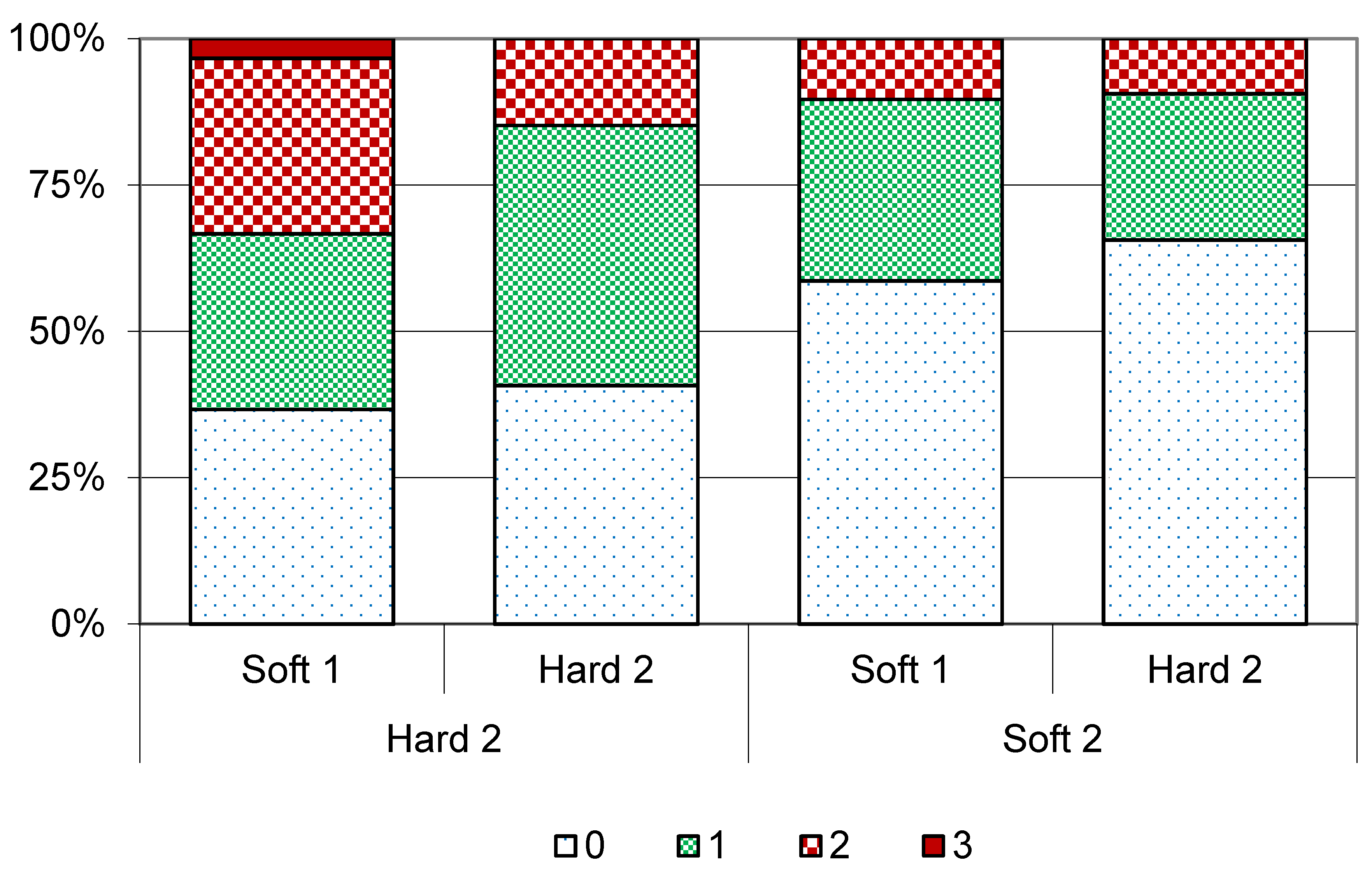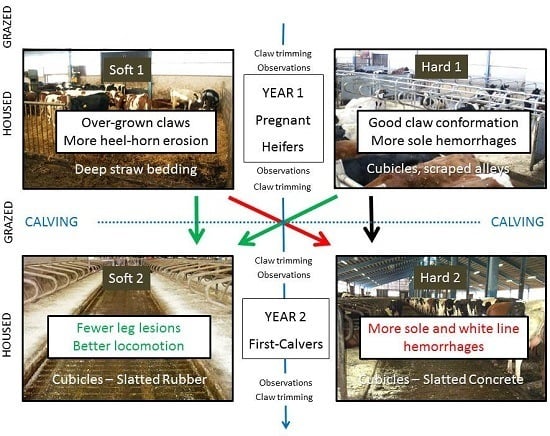Management and housing in the transition period is known to be highly important for future production and health in dairy cows. The importance of conditions provided for recruitment heifers on their future performance does not receive much attention in the literature. However, already from the beginning of gestation pregnant heifers have to adapt to both physiological and management changes. It is thus important to supervise their management not only during the transition period but also throughout their gestation. The experimental 2 × 2 factor layout used in this study aimed to compare the effects of different flooring systems for heifers in the year before and the year after calving during two consecutive housing seasons.
Unfortunately, not all the initial hypotheses in this study could be tested given the statistical power of the study. The somewhat lower frequency of lesions in this study could be explained by the extended grazing period, frequent claw trimming and the organic production regime. A higher frequency of lesions could be expected under more intensive production conditions, less claw care and with zero grazing. However, it is still important to describe the observed biological effects of housing of recruitment heifers for future feet and leg health in first-calving heifers.
5.2. Leg Lesions
The finding that heifers in deep straw bedding (Soft 1) were virtually free from leg lesions when they were examined at the end of the housing period Year 1 is not surprising. It is also not surprising that the heifers in concrete cubicles were more affected and had more severe leg lesions, especially of front leg knees (carpus). These leg injuries are to a very large extent related to the lying surface and space available, and have been highlighted in previous studies. Livesey
et al. [
22] clearly showed that cows on a straw yard had least hock injuries, followed by cows in cubicles equipped with mattresses or rubber mats. Haskell
et al. [
23] also showed fewer leg injuries in straw yards and fewer leg lesions in cows on pasture than in animals that never went out to pasture. Concrete surfaces were not included in these comparisons, but, in other studies, the preference for various surfaces other than concrete, such as mattresses and rubber mats, was always higher [
24,
25].
In the milking group (Year 2), all the cubicles (Hard 2 and Soft 2) were equipped with identical mattresses (KEW plus™, Kraiburg). Although these mattresses were considerably softer than the rubber mats in the heifer compartment, most first-calving heifers had a certain hairlessness and swelling. Obviously the sensitivity to leg injuries was greater in first-calving heifers, which can be associated with increased weight and increased metabolic load. It is well known that sand stalls usually produce fewer and less serious hock lesions than rubber chip mattresses [
19,
26]. Despite the large difference in the leg health of heifers and although a lower frequency was seen in animals that came from deep straw bedding in our study, it did not result in any statistically significant difference regarding the previous rearing system of the heifers. It is likely that the long grazing period between the two housing periods studied levelled out any effects. Regardless of previous flooring system, first-calving heifers on slatted concrete floors (Hard 2) had more hairlessness and swelling, and significantly more ulcers, than those on slatted rubber mats (Soft 2). This finding highlights the importance of exposure time for leg injuries, because all the animals had exactly the same bedding. Thus, the effect was indirectly caused by the alley flooring. Either the animals were lying more because of sore claws owing to the higher prevalence of haemorrhages and ulcers of the claws, or lying less and with shorter lying bouts because of higher comfort with rubber in the alleys reducing the risk of leg injuries. It has previously been shown that the activity and social behaviour of cows in rubber alleys is increased compared with that of cows in concrete alleys [
27,
28].
5.3. Claw Disorders
In the present study, the trimming itself was a method of assessing claw disorders and at the same time certainly confounded the results, because trimming is a measure to improve conformation and to prevent claw disorders [
20]. Thus, the heifers’ feet were trimmed regularly three times during the study, plus at the final examination after their first lactation, which almost certainly reduced the risk of claw disorders appearing and developing. However, there were significant differences in claw health between different flooring systems, even if only weak significant differences could be detected in some comparisons.
There was a higher prevalence of dermatitis in Hard 1 than in Soft 1. The ability to maintain good hygiene is a key attribute in a dairy house, with hygiene of alleys in particular directly correlated to foot hygiene and infectious claw disorders. The accumulation of manure and urine increases ammonium emissions and creates good conditions for the growth of bacteria that cause claw diseases [
29,
30]. In addition to the increased risk of infections, because the cows have to walk and stand in manure, the claw horn and skin is softened and becomes more vulnerable. In scraped alleys, the risk of encountering urine mixed with manure, which increases release of ammonia, is higher. If urine can be separated from manure by sloping or slatted flooring, the floor environment will improve, as will foot hygiene and hygiene-related claw disorders [
31]. In Hard 1, heifers had to walk and stand on the non-drained, concrete alleys for a longer period than in Soft 1 in order to find their cubicle. With more exposure to urine and manure on walking surfaces, the risk of dermatitis increases and therefore also the risk of heel-horn erosion, which usually arises secondary to dermatitis [
29,
32]. Dermatitis disturbs the formation of new heel horn from the coronary band and is to some extent keratinolytic on the surface of the claw horn [
33].
Because dermatitis was less prevalent in Soft 1, it was surprising that heel-horn erosion was more prevalent in Soft 1 than in Hard 1 after the housing season. A previous study [
34] also reported more heel-horn erosion in heifers in a straw yard compared with cubicles, but dermatitis was not recorded. When the dermatitis heals, spontaneously or by some intervention, new skin is rapidly formed. However, when the heel horn starts to recover, it takes months for old cracks to be replaced with new heel horn. Therefore, heel-horn erosion can persist for a long time after dermatitis has disappeared. Moreover, the faster the horn grows, the faster the erosions recover, provided that no new dermatitis develops. The heel-horn erosion could have persisted longer on deep straw bedding because of less wear and lower net growth compared with Hard 1, where the heel-horn erosion might have been worn away and been replaced more quickly because of the higher wear and growth rate. After the grazing period, the prevalence of dermatitis and heel-horn erosion decreased in all animals and did not differ between groups, which is consistent with earlier studies [
35].
First-calving heifers walked on slatted floors except for the twice daily stay in the milking area. The drainage of urine and manure from slatted floors is dependent on drainage area, manure consistency, cow traffic, amount of litter on the floors
etc. In the present study, heel-horn erosion was more prevalent in first-calving heifers in Soft 2, although dermatitis was equally prevalent as in Hard 2. Vanegas
et al. [
21] also recorded more heel-horn erosion in cows with rubber mat alleys than on concrete. However, if heel-horn erosion was established in the early housing period in animals of both groups, the lesions can possibly have been conserved longer, until spring trimming in animals on rubber with less wear than on concrete. That is the same explanation as for the recruitment heifers. Another explanation is reasonable in this study. When covering the original concrete slats with slatted rubber mats, the drainage area was reduced from 20% to 15% because of the reinforced construction and by reducing openings from 4 cm to 3.5 cm. Thus, the drainage of manure decreased, hygiene was impaired and the risk of heel-horn erosion increased. Using scraping robots or scraping devices available on the market could easily solve this problem.
The higher prevalence of sole haemorrhages in Hard 1 and the connections with conformation and weight bearing have already been discussed. Haemorrhages of the sole horn are a sign of erythrocytes and serum leaking from the capillary bed in the corium, which is incorporated in the growing horn and reaches the sole surface 2–3 months later. If the protective wall is worn down by longer exposure to abrasive flooring or over-trimming, a higher load is directed to the sensitive horn-producing sole corium, causing traumatic injury [
16]. White-line haemorrhages have a somewhat different development and are considered to appear some weeks before sole haemorrhages [
36,
37]. The laminitis-related lesions and related damage are also strongly related to hormonal, metabolic and management changes around calving [
38,
39]. As diets, feeding and any management practice other than the flooring system were identical between the experimental groups, it is most likely that these detected differences between soft and hard floorings had a biomechanical/traumatic background. The higher wall and thus a higher maximum point load on the bearing surface in Soft 1 heifers might have resulted in more damage of the white line. However, the hoof wall is the strongest part of the claw and can withstand a heavy load in a vertical direction. Lesions and cracks of the white line are the result of poor quality horn produced from the lamellar corium and can result in white-line ulceration and abscess due to the oblique strain that arises when animals turn on the loaded claw. For animals on deep straw bedding this risk was minimised because all rising and lying was on soft ground and the claws were only exposed to concrete during feeding. The larger point load that was recorded for heifers in Soft 1 was highly probably applied on the bearing surface of the wall and was therefore dispersed on a large area of lamellae (representing the wall and bearing surface), which reduced the risk of sole haemorrhages.
The results from spring claw trimming give a retrospective view of the claw disorders during the housing season for the two experimental groups Hard 2 and Soft 2 and, indirectly, the previous experimental groups Hard 1 and Soft 1. The two flooring systems seemed to have a far greater impact on the claw health of the first-calving heifers than of the recruitment heifers, as also shown by Chaplin
et al. [
40] and discussed above. Bergsten and Frank [
41] tried to provoke sole haemorrhages with only high concentrate feeding of pregnant heifers, without any significant results. On the other hand, the same animals reacted significantly more on similar diets after calving [
42]. The present study clearly showed that the slatted rubber flooring resulted in lower prevalence of sole and white-line haemorrhages. While Bergsten and Frank [
42] saw a smaller increase of sole haemorrhages in tied first-calving heifers on rubber compared with concrete, it is difficult to judge whether this was a result of less exposure due to more comfortable lying or less traumatic influence of rubber when standing compared with concrete. Other studies have presented results confirming that comfortable bedding reduces the risk of claw disorders and lameness [
10,
43]. Thus, the present study more clearly confirms that rubber itself reduced the risk of sole and white-line haemorrhages (including sole ulcers) because cows are more likely to stand for longer on rubber than on concrete [
27,
44,
45] and in this study the bedding was exactly the same. A previous study [
46] showed that the prevalence of sole and white-line haemorrhages was lower in first-calving heifers that were kept on a straw yard also after calving than in cubicles and concrete alleys (irrespective of bedding type). If the introduction to a hard surface can be avoided or delayed in connection with calving, the risk of sole and white-line haemorrhages, sole ulcers and lameness can be reduced. Spring calving heifers that were adapted to concrete floors during a longer time period thus had a significantly lower increase in sole haemorrhages than those that came directly from pasture to concrete floors [
42]. Boyle
et al. [
47] found no difference in claw disorders between cows on rubber or concrete alleys, but cows on concrete alleys stood more in the soft stalls, which was suggested to have the same relieving effect as standing on rubber in the alleys. In other contexts, it has been shown that to avoid sole ulcers and sole haemorrhages, the floor should be slightly shock absorbing and slip resistant [
48,
49]. As the transition period is of special concern for changes of flooring during this time, such changes should be avoided if possible. Webster [
50] clearly showed that keeping heifers in a straw yard until eight weeks after calving, compared with moving them to cubicles with concrete flooring four weeks before calving, significantly reduced the severity of sole haemorrhages and sole ulcers. However, it is unclear how the young stock was managed in that study. Because the exposure time for the different floors was not assessed in the present study and because all animals had rubber in the feed stalls in front of the feeding platform, it is likely that the differences between Soft 2 and Hard 2 were even larger than revealed. Furthermore, our earlier studies have shown that if cows are given the opportunity to choose, the majority choose softer flooring (rubber mat) over harder (concrete) flooring, both when walking and standing [
51].
5.4. Influence of Recruitment Heifer Floorings on Claw Disorders and Locomotion in the Milking Herd
The intention of this study was to determine whether previous rearing of heifers on soft or hard flooring systems affected claw health and locomotion at their first lactation. It has long been a clinical observation that adapting heifers to their first lactation is of great importance, although adapting to new flooring several weeks ahead is not enough [
50,
52]. In both Soft 2 and Hard 2, the prevalence and severity of haemorrhages of the sole and white line were higher when the heifers came from Soft 1 compared with Hard 1, confirming our hypothesis. On the other hand, the heifers with the least number of haemorrhages and the least severity were those coming from Hard 1 and calving in Soft 2. It seems as though a traumatic claw challenge by hard flooring, resulting in sole haemorrhages during the rearing period, was beneficial for heifers after calving. This could be because heifers were able to cope with disorders while not subjected to the challenges of the transition period. If the animals obtain their first experience of hard floors during the transition period, their chances to cope with laminitis-related disorders are much lower, which explains the higher prevalence of these lesions in heifers reared on straw beds (Soft 1) and moved to concrete alleys (Hard 2) than in those moved from Hard 1 to Soft 2 flooring. For different reasons, the hypothesis could not be fully explored. First, all heifers were grazed between the housing seasons and the time for grazing was extended on the organic experimental farm, which would have equalised adaptation. Secondly, the claws were trimmed rather frequently and abnormal conformation with overgrowth was corrected, which would have equalised weight distribution for both Soft 1 and Hard 1. Thirdly, the study farm normally had at least a three-week adaptation period to the dairy house, which was the same for both groups. Therefore, preventive trimming to give a claw conformation with optimal weight distribution and a long-term adaptation avoiding changing from soft to hard flooring during the transition period could be advised to reduce the risk of trauma-related sole lesions for first-calving heifers.
Although no severe lameness was detected, locomotion was significantly less affected in first-calving heifers on slatted rubber floors than on slatted concrete floors. Vanegas
et al. [
21] also found less lameness on solid rubber flooring compared with solid concrete when cubicles were identical. Because lameness is usually a result of claw injuries [
53,
54] and more disorders of the sole and white line were seen on the concrete floors, these lesions may certainly explain this difference. Heel-horn erosion normally does not lead to lameness and there was no difference in the prevalence of dermatitis between the two groups of first-calving heifers. The leg lesions (hock ulcers) could also have contributed to higher locomotion scores. However, cause-effect is not clear and the leg lesions could equally well be explained by a longer lying time due to poor locomotion. Haskell
et al. [
23] found a higher prevalence of lameness and leg lesions in animals that were zero-grazed than in those which were grazed, and in cows housed in free stalls with concrete alleys than in those housed in straw yards. All the cows in the present study were grazed for four months and all cows had feed stalls with rubber mats, both of which are preventive measures for lameness.
